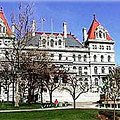- By Emily DeSantis
- News
 Print
Print  New York state will face a cumulative spending gap that could exceed $37 billion through State Fiscal Year (SFY) 2013-14 largely because policymakers depended on temporary and non-recurring resources in the near term without a permanent long-term solution, according to a report State Comptroller Thomas P. DiNapoli released today.
New York state will face a cumulative spending gap that could exceed $37 billion through State Fiscal Year (SFY) 2013-14 largely because policymakers depended on temporary and non-recurring resources in the near term without a permanent long-term solution, according to a report State Comptroller Thomas P. DiNapoli released today.“There was an opportunity to begin addressing the structural deficit by using temporary resources as a bridge to reform,” DiNapoli said. “Instead, these resources were again used to prop up unsustainable spending. Nothing was done to reform how the budget is planned or constructed, and taxpayers will continue to pay the price for the state’s short-sightedness.”
DiNapoli’s annual financial condition report on the state’s fiscal health indicated that total state spending increased to $126.9 billion in SFY 2009-10, representing a 21.7 percent increase since 2006, more than double the rate of inflation over the same period. Spending in the state is projected to reach $153.2 billion by SFY 2013-14, an increase of nearly 21 percent from SFY 2009-10. However, over the same period, revenue is projected to increase by less than 9 percent.
State-funded debt is also expected to increase by more than $6.5 billion to $67 billion in SFY 2014-15, up from $60.5 billion in the last fiscal year. The increase in debt is expected to add $1.8 billion to the annual cost of debt service, bringing total debt service to $7.7 billion by SFY 2014-15. Debt service continues to be one of the fastest growing major categories in the budget.
Other findings in DiNapoli’s report include:
- Property tax levies increased by 6.1 percent in 2009, even though personal income and inflation both declined as a result of the recession;
- In October 2009, unemployment rates increased to 10.1 percent for the nation (a 26-year high) and 8.9 percent for the State (a 17-year high). However, both national and state rates declined by March 2010 (9.7 percent and 8.6 percent respectively);
- The number of homes sold in 2009 is 20 percent lower than 2007 total sales and sale prices declined more than 15 percent over the same period;
- In 2009, New York was the second most indebted state behind California and had nearly twice as much debt as the third most indebted state, New Jersey;
- Spending growth is projected to be concentrated in the categories of Medicaid, school aid, debt service and general state charges. Combined, these categories represented 55.3 percent of All Governmental Funds spending in SFY 2009-10. The share is projected to grow to 60.1 percent in SFY 2013-14, representing more than 83 percent of projected growth; and
- The SFY 2010-11 Enacted Five-Year Capital Program and Financing Plan, projects average capital spending of $9.3 billion per year through SFY 2014-15.
----
v6i38



